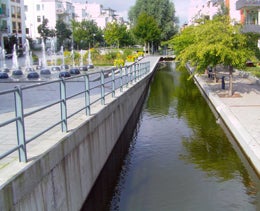
Starting about a decade ago, the planners took on the ambitious goal of reducing the environmental footprint of the neighborhood by 50% compared to other recent developments in Stockholm. They brought in new ideas and put them into practice at surprisingly low costs.
While I was in Stockholm for World Water Week this past week, I spoke to Erik Freudenthal from GlashusEtt in Hammerby Sjöstad about the project.
“When we started,” he said, “many private developers said that we could not reduce our environmental footprint by 50%, but according to those developers who tried and succeeded, in the end it only added 2-4% to building and infrastructure costs.”
Integrated urban planning was a major reason for this success. From the first day, the planning effort for the development area included all the relevant authorities and private partners around the same table. As a result, it was possible to integrate solutions that are often separated.
Water is a prime example: “We use the water from Lake Mälaren five times before we discharge it to the Baltic Sea,” Erik told me. Here's how it works: 
- First, they treat it for drinking water purposes.
- Next, in the wastewater treatment plant, they separate sludge and make biogas.
- The residual sludge is sold to farmers as fertilizer – that’s the third use.
- The cleaned wastewater is pumped to the district heating plant, where heat exchanges capture heat and in the process reduce the wastewater temperature to approximately 4 degrees.
- Finally, the cold wastewater is used for district cooling in schools and public buildings before it is pumped to the sea.
I asked Erik if he had any advice for other cities.
“We succeeded because we set an ambitious goal and got everyone involved from the beginning,” he said. “We have 10,000 visitors annually who want to learn from us.”
The World Bank is currently working with several cities, including the city of Nairobi, to explore options for similar gains through integrated urban water management.
Read more about integrated urban water management in the recent World Bank publication The Future of Water in African Cities: Why Waste Water?


Join the Conversation